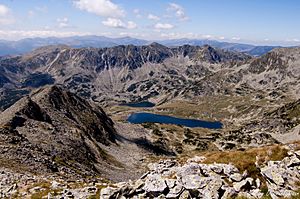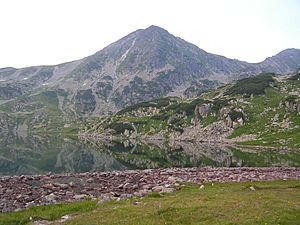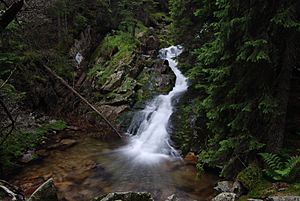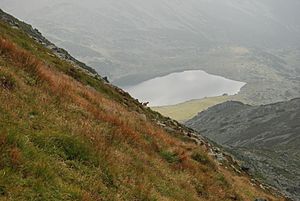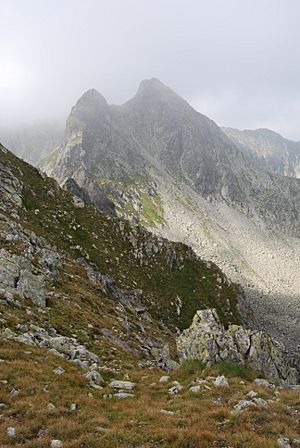Retezat Mountains facts for kids
Quick facts for kids Retezat mountains |
|
|---|---|

The Retezat Mountains seen from atop one of them (Vârfu Mare, "The Big Peak")
|
|
| Highest point | |
| Peak | Peleaga |
| Elevation | 2,509 m (8,232 ft) |
| Geography | |
| Country | Romania |
| State/Province | Southern Carpathians |
| Range coordinates | 45°22′N 22°52′E / 45.367°N 22.867°E |
| Borders on | Alps |
| Geology | |
| Orogeny | Alpine orogeny |
The Retezat Mountains (which means "cut off" in Romanian) are a tall mountain range in Romania. They are part of the Southern Carpathians, a large mountain system. The highest point in the Retezat Mountains is Peleaga Peak, standing at 2,509 meters (about 8,232 feet) tall. Other important peaks include Păpuşa (which means "the Doll Peak") and Retezat Peak.
Contents
Exploring the Retezat Mountains
The Retezat Mountains are famous for their many glacial lakes. These lakes were formed by ancient glaciers. One of the most well-known is Bucura Lake (Lacul Bucura), which is the largest glacial lake in Romania. It covers an area of about 8.9 hectares (around 22 acres) and is located at an altitude of 2,030 meters (about 6,660 feet).
This area is also home to the Retezat National Park, which was Romania's very first national park. It's a special place protected for its amazing nature.
Rivers and Lakes: Water in the Mountains
The Retezat Mountains get a lot of rain and snow, making them one of the wettest areas in the Romanian Carpathians. This is because of the way the mountains are shaped and where they are located.
The water from the mountains flows in two main directions:
- North: Rivers flow towards the Strei River, which then joins the Mureş River. This includes rivers from the west, north, and northeast parts of the mountains.
- South: Rivers flow towards the Jiul de Vest River, which is part of the Jiu River system.
The most important river here is the Lăpuşnicul Mare. You can find many beautiful waterfalls on almost all the streams and rivers in the park.
A unique feature of the Retezat Mountains is the large number of glacier lakes. About 38% of all the glacier lakes in Romania are found here! They are often grouped together in clusters or found alone in bowl-shaped valleys called calderas. These lakes are a big reason why tourists visit the park.
There are 58 permanent glacier lakes in the Retezat Mountains, located between 1,700 meters and 2,300 meters high. Some people say there are over 80 lakes, but this probably includes lakes that only appear for a short time.
The size of these lakes varies a lot. The smallest, Stânișoara I, is only about 300 square meters. The largest is Bucura Lake, covering about 88,612 square meters. The depth also changes, from 0.3 meters (Stânișoara I) to 29 meters (Zănoaga Lake).
Plant Life: The Flora of Retezat
The Retezat Mountains are incredibly rich in plant life. Out of about 3,500 different plant species found in Romania, more than a third (around 1,200) grow here! This is a major reason why the area became a National park.
There are over 90 plant species that are unique to this area, meaning they don't grow naturally anywhere else in the world. The first unique plant, called Flămânzica (Draba dorneri), was discovered here in 1858.
Alpine Meadows and Special Plants
The high-altitude alpine meadows are very important. Many alpine plants, like different types of Gentiana, Potentilla, and Pulsatilla, grow here. You can also find the beautiful edelweiss flower. Near the rocky areas, you might spot rhododendron bushes (Rhododendron kotschii).
The mountain pine is a protected species in Romania and grows on the steep slopes of the Retezat Mountains. The Swiss pine (Pinus cembra) is also found here more than in any other Romanian mountain range.
Other interesting plants include:
- Hawkweed (Hieracium borzae and Hieracium nigrilacus)
- Unique types of Centaurea (Centaurea pseudophrygia ratezatensis)
- Cat's ear (Hypochaeris maculata)
- A unique type of locoweed (Oxytropis jacquinii retezatensis)
- Gentiana lutea (known as Ghinţura galbenă in Romanian)
On the limestone areas of the Small Retezat, many rare or unique species grow. These include Barbarea lepuznica (a type of Winter cress) and Pedicularis baumgarteni.
One of the biggest threats to the park's plants, especially those in the alpine meadows, is overgrazing. This happens when too many sheep eat the plants. The special plants that belong here can be replaced by other, tougher species.
Animal Life: The Fauna of Retezat
The Retezat National Park is a haven for animals. Over 185 species of birds visit the park, which is more than half of all the bird species found in Romania! More than 122 of these species even build their nests here.
Birds of the Retezat Mountains
Rare birds that live here include:
- The golden eagle (which is on the park's logo!)
- Lesser spotted eagle
- Short-toed eagle
- Peregrine falcon
- Western capercaillie
- Eurasian eagle-owl
- Eurasian pygmy-owl
- The black stork
Mammals and Other Animals
There are 55 species of mammals living in the park. The Retezat Mountains provide a good home for some of Europe's largest predators, such as the gray wolf, brown bear, and the Eurasian lynx. Large plant-eating animals (herbivores) like the chamois, red deer, and roe deer also live here. Smaller carnivores like the wildcat and the European otter can be found too.
In 1973, 20 alpine marmots were brought from the Austrian Alps and released into the park near the Gemenele glacier lake. Today, they live all over the park. Scientists are still studying what effect these new animals have had on the other plants and animals. Also, after 1960, brown trout fish were put into some of the park's lakes. Studies are now looking into whether these fish are causing a decrease in the number of amphibians (like frogs and newts) in these lakes.
A special type of smooth newt (L. vulgaris ampelensis), which is unique to the Carpathian Mountains, lives here. The European common frog can be found throughout the park. While very few bites from the common European viper have been reported, tourists and local villagers sometimes kill them when they see them.
The park also has several unique invertebrate species. These include nine types of butterflies found nowhere else, at least six species of stoneflies, and four species of caddisflies.
Images for kids
-
Bucura Peak as seen during spring from the Retezat Peak.
See also
 In Spanish: Montañas Retezat para niños
In Spanish: Montañas Retezat para niños



